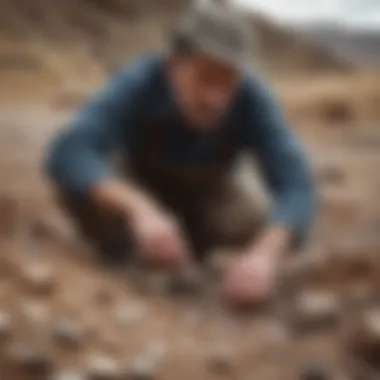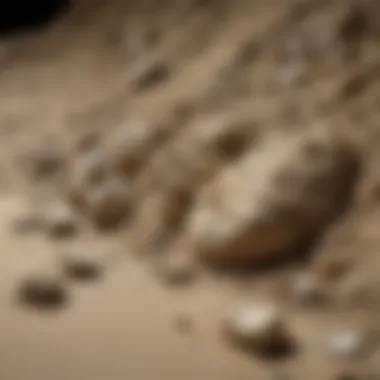Techniques and Tools for Rock Sifters in Geology


Intro
In the realms of geology and paleontology, the pursuit of knowledge often intersects with the art of collecting. Rock sifters emerge as essential tools in this journey, assisting enthusiasts and professionals alike in their quest for understanding the earth's past. The employment of rock sifters is not merely a task; it's a blend of science and passion. From identifying mineral specimens to unearthing fossilized remnants of ancient life, these tools are crucial for anyone embarking on a geological expedition.
Understanding the variety and function of rock sifters can greatly enhance one's collecting experience. It goes beyond the mere act of sifting through dirt; it calls for an appreciation of the intricacies involved in techniques, tools, and applications that can make or break a collector's efforts. This article dives deep into the world of rock sifters, uncovering their significance and utility while addressing the challenges they present.
Featured Collectible of the Month
Each month, the spotlight falls on a unique collectible, illustrating its place in the rich tapestry of geological discovery. This month, we focus on the striking Agate, a popular choice among collectors.
Overview
Agate is a banded form of chalcedony, a mineral that captivates with its vibrant colors and intricate patterns. Its formation results from layers of silica deposits, which create a stunning variety of appearances. Whether you’re a seasoned collector or just getting your feet wet, agate serves as a wonderful entry point into the world of rock collection.
Historical Significance
Historically, agate has held great significance in various cultures. Ancient civilizations, including the Egyptians and Romans, valued this mineral not just for its beauty but also for its perceived protective qualities. Sifted through the annals of geological time, agate tells a story—one that connects us to our ancestors and the earth itself.
Identification Techniques
Identifying a rock can often feel like a guessing game, but with the right techniques, one can piece together the clues hidden in nature’s bounty.
Visual Characteristics
When it comes to agate, the first step is often visual. Look for:
- Transparency: Agate can range from fully transparent to entirely opaque.
- Banded Patterns: Distinct layers are often present, which can differ in thickness and color.
- Color Variations: From earthy browns and reds to vibrant blues and greens, agate’s color can be quite diverse.
These visual traits can guide collectors in the identification process, making it easier to distinguish agate from other minerals.
Resources for Identification
For those keen on refining their identification skills, several resources can aid in this journey:
- Books: Field guides that focus on regional minerals can be invaluable.
- Online Communities: Websites like reddit.com offer platforms to connect with other collectors.
- Workshops: Engaging in hands-on workshops enhances both skill and knowledge under the guidance of experts.
By tapping into these resources, collectors can build a solid foundation in identification techniques, increasing their confidence and enhancing their enjoyment of the hobby.
"Knowledge is the key that unlocks the treasures of the earth."
This journey through the world of rock sifters leads us not only to the tools themselves but to a broader understanding of why they matter in the continuum of our planet's history. The following sections will expound upon various techniques, delve into practical applications, and discuss the nuances of care and maintenance to better inform the reader’s collecting endeavors.
Prelims to Rock Sifters
The realm of rock sifting may seem niche, yet it possesses a significant role in geology and paleontology. For hobbyists and professionals alike, rock sifters are essential tools that sift through rubble, separating valuable specimens from unremarkable debris. Understanding how they function is vital. Sifters not only streamline the collection process but also enhance the efficiency and accuracy of locating intriguing rocks and fossils. This section dives into the foundational aspects of rock sifting, ensuring readers recognize its importance and can appreciate the tools at their disposal.
Definition and Purpose
Rock sifters can be defined as tools designed to strain or sift through soil, sand, or gravel, specifically targeting rock and fossil specimens hidden among sediments. The primary purpose of sifting is to separate materials by size, enabling collectors to distinguish finer fragments from larger debris. In practical terms, one might visualize a backyard filled with rocks; the sifter helps sort through the clutter to uncover a unique fossil or mineral.
Sifters come in various forms, from simple handheld devices to complex mechanized models. They significantly improve the quality of collection, enabling enthusiasts not to miss out on rare finds. Additionally, using a sifter can be a more methodical approach to collecting, which is increasingly essential in competitive contexts like fossil expeditions or professional geological surveys.
Historical Context
The history of rock sifters is a tale of innovation driven by necessity. Earliest references to sifting techniques can be traced back to ancient civilizations, where people utilized rudimentary sifting methods to find precious materials such as gold and gem stones. Archaeological discoveries show that people fashioned simple wooden or metal frames to create sieves, limiting lost treasures from their grasp. As civilizations advanced, so did the tools and techniques employed for sifting.
By the time of the Industrial Revolution, mechanical advancements birthed enhanced sifting devices. These innovations transformed the principles of rock sifting; no longer were collectors solely reliant on manual labor. The incorporation of machines allowed for larger quantities of material to be processed at a quicker rate, which raised efficiency levels not previously imaginable.
In contemporary terms, we see the impact of historical methods remaining relevant. Modern collectors can appreciate both the artistry of traditional hand sifters and the efficiency of newly designed machinery. This dynamic evolution shows a blending of heritage with technical progress, ensuring that the art of sifting remains a vital component of geology and paleontology today.
"The act of sifting through earth, stone, and time connects us to our past, revealing history layered within the soil beneath our feet."
Understanding the history and purpose behind rock sifters allows for a more profound appreciation of the craft. As we transition into types of rock sifters, we will further elaborate on the spectrum of options available, catering to various needs and preferences.
Types of Rock Sifters
Understanding the different types of rock sifters is essential for anyone serious about rock collecting, whether they are hobbyists dabbling in nature or professionals conducting serious geological research. Each variety of sifter comes with specific benefits and applications, allowing users to tailor their approach based on the task at hand. The right selection can significantly enhance efficiency, accuracy, and overall satisfaction in the sifting process. So, let's dig deeper into the varieties that are most commonly used.


Manual Sifters
Manual sifters are the bread and butter for many rock and fossil collectors. Often favored for their simplicity and low cost, these tools require no electricity, only the skill and strength of the user. Typically made from wood or metal mesh, manual sifters come in various sizes and grades to accommodate different types of materials.
For instance, a simple wooden frame with mesh can be efficient in separating larger pieces from finer materials. It serves as an excellent choice for someone who enjoys working outdoors while staying connected to nature. In many cases, collectors find they appreciate the tactile feedback provided by manually sifting through materials, as it can lead to unexpected finds.
Despite their charm, these sifters have some drawbacks. The manual effort can be taxing, especially during long sessions. Also, the process can be time-consuming, which may dissuade some individuals from using them extensively. Still, for those who prefer a hands-on experience, manual sifters remain an indispensable tool.
Mechanical Sifters
Stepping up from manual options, mechanical sifters are a game-changing innovation for serious collectors and professionals alike. These instruments employ motors and mechanisms to automate the separating process, which significantly enhances speed and efficiency.
Mechanical sifters come in various forms, ranging from vibrational to rotary devices. They can handle larger quantities of materials, making them suitable for excavation sites or educational settings where multiple samples require analysis. One could argue that these tools mark a significant leap forward in modern geology and paleontology practices.
While the benefits are apparent, it is crucial to note that mechanical sifters do have higher upfront costs and require a power source, limiting their use in remote areas. Furthermore, they demand maintenance to ensure longevity and functionality. A well-balanced consideration of pros and cons is necessary before integrating such equipment into your collection activities.
Custom-Built Sifters
For those who want to elevate their rock-sifting game, custom-built sifters offer a unique pathway. These tools can be designed specifically for the collector’s individual and specific needs. Whether it involves different mesh sizes or specialized designs to fit particular excavation requirements, custom sifters can provide tailored solutions like nothing else.
Typically constructed using materials such as aluminum or stainless steel, these sifters can be both durable and lightweight. Several enthusiasts have even gone the extra mile, integrating advanced features like adjustable mesh levels to cater to the varying size of rocks and fossils.
On the downside, custom-built options generally demand higher financial investment and technical expertise for assembly and maintenance. They may also require research and collaboration with skilled professionals to determine suitable designs. Nonetheless, for those dedicated to their craft, the customization possibilities make these sifters an attractive choice.
Each type of sifting tool serves a distinct purpose, and choosing wisely can make a world of difference in your collection endeavors. As you progress in your journey, consider your specific needs and the tasks ahead, ensuring that you choose the right sifter to maximize your efforts in this fascinating pursuit.
Materials Commonly Used with Rock Sifters
Understanding the materials associated with rock sifters is essential for maximizing their effectiveness. This topic delves into the types of rocks and fossils enthusiasts might encounter during sifting, along with the sifting media that facilitate efficient processing. When one considers the purpose of rock sifters—not only to extract valuable specimens but also to preserve their integrity—the choice of materials becomes pivotal.
Types of Rocks and Fossils
In the world of rock sifting, the variety of rocks and fossils can feel as vast as an open field. These materials can range from sedimentary rocks, which often house fossils, to igneous and metamorphic types, each presenting unique challenges and opportunities for collectors. For example:
- Sedimentary Rocks: Formed from particles cemented over time, they often hold fossils and are prime candidates for sifting. Sandstones or shales may contain delicate imprints of ancient flora and fauna, waiting to be uncovered.
- Igneous Rocks: Typically formed from cooled magma, these can sometimes surprise you. They might hold precious gems, but you will need special techniques and tools to sift through them.
- Metamorphic Rocks: Created under intense heat and pressure, they may not be the first choice for amateurs, but the finds can be rewarding, with minerals occasionally revealing themselves.
Fossils, too, vary widely. They might include common specimens like trilobites or more elusive finds like dinosaur bones. The type of material you sift through will dictate the tools and techniques you employ, suggesting that understanding your target specimens is essential before you even start sifting.
Sifting Media
The medium through which one sifts can make all the difference in both the outcome and the efficiency of the process. Essentially, sifting media are the various substances or arrangements through which rocks and fossils pass. These can include:
- Mesh Screens: Commonly made of metal or plastic, these screens are available in different mesh sizes, allowing specific grades of rocks and fossils to pass through while retaining larger debris.
- Vibrating Tables: For those with the means, a vibrating table can enhance the sifting process, using vibrations to encourage separation of materials based on weight and size.
- Fluidized Beds: Occasionally seen in specialized setups, these allow for a unique means of separation, where lighter materials float away, leaving heavier specimens settled below.
Choosing the right sifting media is critical, as it not only affects the efficiency of the sifting experience but also the preservation of the items collected. Using a mesh that is too coarse might let desired fossils slip through, while one that's too fine could hinder your progress.
"The medium effectively defines the conversation between the material and the sifter. Knowing your media can elevate an average sifting session to something extraordinary."
In summary, grasping the types of rocks and fossils relevant to your sifting endeavors and carefully choosing sifting media are integral to successful and meaningful collection efforts. This detailed insight digs into both the practical and technical aspects, serving the needs of rock and fossil collectors on their journey.
Operational Techniques
Understanding the operational techniques behind rock sifting is key for both amateurs and seasoned geologists. Efficient sifting can save a significant amount of time and effort, allowing enthusiasts to focus on what truly matters: finding those hidden treasures in the ground. This section breaks down the foundational methods of rock sifting plus additional advanced strategies that can elevate one’s collecting experience.
Basic Sifting Methods
At the heart of rock sifting lie a few essential methods. Starting with the basics, you can siphon through material with a manual sifter or a screen that fits within a wooden frame. The idea is simple: pour your material onto the sifter and shake it gently so finer materials drop through. Here’s a closer look:
- Hand Sifting: This method involves the use of a sieve to separate materials by size. The sieves can vary in mesh size, significant when attempting to find specific fossils or rocks.
- Wet Sifting: Sometimes, a littlewater can be your best friend. Using a hose or bucket to moisten the material prior can help in breaking down denser aggregates, allowing fine materials to separate more easily.
- Tumbling: While usually associated with polishing stones, tumbling can also be adapted for sifting. Introducing small stones into a rotating drum with water can help separate finer materials if done properly.
These basic techniques form the foundation for more elaborate measures, allowing beginners to gradually build their skills.
Advanced Sifting Techniques
Once you’ve grasped the basic operations, it’s time to kick things up a notch with advanced techniques. These methods often require slightly more investment in equipment but can yield remarkable results:
- Vibrating Screens: These screens use vibration to shake the material through mesh, ensuring a more thorough separation. Investing in a small vibrating sifter can save muscle strain and labor, particularly when working bigger batches.
- Air Sifting: A method that utilizes a fan or blower directed at a sieve to separate lighter materials from heavier ones. This technique is particularly handy when sifting through sand or light gravel.
- Mechanical Rock Separators: More complex devices are available, which can automate much of the process. These devices can sort rocks, minerals, and fossils by size using various mechanical elements.
Using these advanced techniques, collectors can efficiently sift through larger amounts of material, extracting specific finds or particular characteristics in their collections.


Tips for Effective Sifting
Successfully sifting through materials requires not just technique, but also strategy. Here are some pearls of wisdom that can enhance the experience:
- Know Your Target: Understanding what exactly you're sifting for can help you select the right tools and methods. Different fossils or rocks may require different handling.
- Adjustment is Key: If the method you’ve been using doesn’t yield results, don’t hesitate to switch it up. Experimenting with different techniques may uncover what works best for your materials.
- Stay Patient: Sifting can sometimes feel like watching paint dry. It’s essential not to rush the process. Taking time to do it right often pays off with quality finds.
- Proper Lighting: If you're sifting outdoors, consider the time of day. More clear sunlight helps bring small details to light, making it easier to spot material against shadows.
Operating a rock sifter efficiently involves a mix of the right techniques and a dash of common sense. Whether you’re just beginning or looking to refine your collection methods, these tips and techniques will set you on a path toward success in your rock collecting endeavors.
Advantages of Using Rock Sifters
Using rock sifters can truly enhance the experience for both amateur and professional collectors. Understanding the advantages they offer is essential to appreciating their role in sifting through the treasures of nature. Here are some compelling benefits that rock sifters bring to the table:
Increased Efficiency
One of the standout benefits of rock sifters is their ability to streamline the process of collection. When you’re sifting through rocky terrain or gravel, doing it by hand can be tedious and slow. Rock sifters, whether manual or mechanical, allow users to process larger volumes of material in a fraction of the time. For instance, a well-designed mechanical sifter can sort out thousands of pounds of gravel within a matter of hours. This time-saving aspect frees up collectors to focus on what they love most – discovering the fossils and minerals hidden within the earth.
Additionally, because these tools work by using mesh screens or vibrating mechanisms, they effectively separate valuable finds from debris much quicker than manual efforts could. Even in a casual setting like a weekend outing, the efficiency of a sifter can turn a lengthy afternoon of digging into a productive treasure hunt.
Enhanced Accuracy
When it comes to hunting for gems, fossils, or unique rocks, accuracy is key. Rock sifters improve the precision of the sorting process. By using a sifter, collectors can ensure that they don't miss smaller specimens that may slip through the cracks during a manual search. The specific mesh sizes in rock sifters are designed to retain certain rock sizes while allowing smaller particles and debris to fall through. This means that while you’re searching, you’re far more likely to uncover valuable finds.
Moreover, rock sifters significantly reduce the risk of unwanted items ending up in your collection. Say goodbye to unwanted clay, sand, or even hazardous materials. Sifting ensures a cleaner, more curated collection that brings satisfaction to both hobbyists and professionals alike.
"With the right sifter, you quite literally pull hidden treasures from the ground in a way that's both satisfying and scientifically sound."
Cost-Effectiveness
Investing in a rock sifter can be a wise financial decision, particularly for serious hobbyists or professionals. While there is an initial cost associated with purchasing high-quality sifters, the long-term savings are substantial. By making the sifting process more efficient and less labor-intensive, collectors spend less time and resources on trips and shifts through material.
Additionally, the enhanced accuracy means fewer lost finds and less wasted effort trying to sift through unproductive material. Whether one is a casual collector or a geologist conducting expert analysis, rock sifters present a cost-effective solution that maximizes returns on the time and money invested. Furthermore, they often require low maintenance if cared for properly, extending their usability for years.
In summary, using a rock sifter is not just a matter of preference; it’s a strategic approach that blends efficiency, accuracy, and cost-effectiveness. Collectors who recognize these advantages will find themselves more engaged and successful in their endeavors, making their time in nature rewarding and fruitful.
Drawbacks of Rock Sifters
While rock sifters provide numerous benefits to both hobbyists and professionals, they are not without their limitations. Understanding the potential downsides is vital for anyone looking to optimize their sifting experience. The discussion herein delves into two primary drawbacks: the potential for damage and the limitations of use.
Potential for Damage
One of the most pressing concerns regarding rock sifters is the potential for damage they can inflict on both the tools themselves and the materials being sifted. When used improperly, sifters can cause scratches and dents, particularly if they are not made with durable materials. This is particularly true for those who experiment with various rock types. Softer minerals, when sifted with equipment designed for tougher materials, can lead to unwanted loss of structural integrity. It's essential to keep in mind that each rock type has unique properties.
Moreover, if sifters are subjected to excessive force or improper handling, they can compromise their own construction. Some sifters, especially those made from plastic or lower-quality materials, might crack or warp over time. Here’s a list of tips to mitigate the risk of damage:
- Choose the Right Material: Opt for sifters crafted from robust materials like stainless steel or heavy-duty plastic.
- Handle with Care: Always remember that gentle handling goes a long way. Rough usage should be avoided.
- Regular Inspections: Periodically check for wear and tear to prevent unexpected failures during use.
The use of the right techniques ensures the longevity of the sifter and the quality of the material being processed.
Limitations of Use
Another notable drawback revolves around the limitations of rock sifters themselves. While they are effective for certain tasks, they are not a catch-all solution. Specific limitations can impede the sifting process:
- Particle Size: Many sifters are designed to work within a particular particle range. That means finer materials may slip through or become lodged within the sifter, rendering the process less effective.
- Soil Composition: Not every sifter can handle different soil types. For instance, the sifting of clay versus gravel will require different approaches and possibly different equipment, thus complicating the process for users not equipped to handle such variability.
- Volume Constraints: Some sifters may be ill-equipped to tackle larger volumes of material at once, which can be a significant downside for professionals operating on tight schedules or needing efficiency in their workflows.
In summary, while rock sifters are invaluable tools in various geological and paleontological pursuits, cognizance of their drawbacks is necessary for making informed choices. Weighing the potential for damage and understanding their limitations can help collectors and professionals alike optimize their experience with these essential tools.
Practical Applications of Rock Sifters
Rock sifters serve a multitude of practical purposes across various domains, proving to be indispensable tools for collectors and professionals alike. Understanding their practical applications not only highlights their value but also emphasizes the distinct roles they play in different fields. From enhancing the collection experience for hobbyists to providing crucial insights in professional geology and paleontology, rock sifters contribute significantly to the study and enjoyment of geology.
Hobbyist Collecting
For many enthusiasts, rock collecting is more than just a pastime; it’s an enriching journey into the natural world. Hobbyist collectors utilize rock sifters to enhance their sifting process, allowing them to isolate interesting specimens from larger deposits of soil or gravel. By using a sifter, they can efficiently separate small, valuable pieces from the rubble, thus increasing their chances of finding rare minerals or fossils.
The thrill of discovery connects collectors to the earth itself. Many have shared stories about what they found hiding beneath layers of dirt. For instance, discovering a quartz crystal or a prehistoric trilobite fossil can be a life-changing moment for some. Others might note that using rock sifters minimizes the time spent on tedious sorting, enabling them to spend more time exploring and enjoying the outdoors.
Professional Geology
In the realm of geology, accuracy is paramount. Professionals rely on rock sifters for meticulous fieldwork, photography, and research. These tools help geologists efficiently sample and analyze sediment without losing essential data. A sifter's ability to categorize materials according to size or composition ensures that every grain is considered during analysis, leading to more accurate geological maps and models.


Moreover, rock sifters enable professionals to track environmental changes over time. By collecting sediment samples, geologists can study factors such as erosion, sediment transport, and even climate shifts, offering valuable insights into Earth’s history. Their influence extends beyond the lab; findings can inform land-use planning and resource management.
Paleontology Studies
Paleontologists utilize rock sifters in their quest to uncover remnants of ancient life. The ability to sift through rock layers enhances their capacity to locate fossils that may be otherwise hidden under the surface. Valuable artifacts can often be so small as to evade the naked eye; the subtlety of a well-constructed sifting process allows for the preservation and identification of these remnants.
Field excavations benefit greatly from this technique. Collectors and researchers suggest that sometimes, a mere extra half-hour of sifting can yield significant discoveries, such as tiny teeth from long-extinct creatures or delicate plant fossils.
"Every grain might hold a story, and it's the meticulous work with rock sifters that brings those tales to light."
Rock sifters transform the tedious process of excavation and stratigraphic sampling into an organized activity. With the right techniques and tools, both hobbyists and professionals can deepen their understanding of the Earth and its historical narratives. From the local rockhounding enthusiast digging for treasures to the seasoned paleontologist unearthing fossils, the impactful uses of rock sifters are evident in every layer of dirt unearthed.
Care and Maintenance of Rock Sifters
Proper care and maintenance of rock sifters is crucial for anyone who takes their rock collecting or sifting ventures seriously. This not only extends the lifespan of your tools but also ensures that they function at their best. When you utilize rock sifters, you expose them to a variety of abrasive materials, and without a little TLC, they can start to show wear and tear pretty quickly. Good maintenance practices can help you avoid costly replacements and keep your work effective, allowing you to focus on the fun part— discovering new specimens.
Cleaning Practices
Cleaning your rock sifter after each use is essential. No one likes dealing with leftover debris from past sifting sessions.
- Rinse Thoroughly: After sifting, rinse the mesh or screen with water. This helps to wash away loose sediment and prevent buildup. You don’t want last week’s find to become tomorrow’s problem.
- Use a Soft Brush: For finer particles that cling stubbornly, grab a soft brush, like a toothbrush, to gently scrub the mesh. Avoid using anything abrasive, as this can damage the surface.
- Mild Detergent: On occasion, using a mild detergent can be helpful if there’s a sticky residue. Just make sure to rinse thoroughly afterward to prevent residue from remaining.
- Dry Properly: After washing, allow your sifter to air dry completely before storing it. This prevents rust, particularly for metal components. Better safe than sorry when it comes to maintenance!
"Regular cleaning habits not only enhance the efficiency of your tools but also uphold the quality of your collection."
Storage Considerations
After keeping your sifters clean, how you store them is equally important. Improper storage can lead to avoidable damage. Here are some points to consider:
- Cool, Dry Place: Always store your rock sifters in a cool, dry place. Humidity can lead to rusting, especially with metal parts. A cabinets or containers with air circulation can be ideal.
- Avoid Heavy Loads: Don’t stack heavy items on top of your sifters. This can warp the structure of the sifter or potentially damage the mesh. Treat them with care, as if they were fragile.
- Labeling: If you own multiple types of sifters, labeling each storage area can help you quickly find the right tool when you need it. Nothing’s worse than fumbling through a pile of tools when you're eager to get out there!
- Protection from Pests: Ensure that your storage area is free from pests. Small creatures can nest in and around your tools. Using airtight containers may provide an extra layer of protection against unwanted pests.
Properly caring for and maintaining your rock sifter can save time and enhance the overall sifting experience. By investing a little time in cleaning and ensuring proper storage, collectors can prolong the life of their tools and keep them in top shape for each new adventure.
Future Trends in Rock Sifting Technologies
The world of rock sifting is constantly evolving, influenced by advances in technology and materials science. Understanding these future trends is essential for enthusiasts who wish to optimize their collecting and research. The rapid pace of innovation not only promises to enhance the efficiency and accuracy of rock sifting but also opens up new horizons of exploration for both casual collectors and professionals in geology and paleontology.
Innovations in Design
New designs in rock sifters have begun to emerge, aiming to improve functionality and user experience. For example, recent iterations of mechanical sifters now incorporate ergonomically engineered handles that reduce strain on hands and wrists during extended use. Such ergonomic considerations matter deeply, especially to those who might be out in the field for long hours.
Moreover, advancements in digital technology have introduced the concept of smart sifters. These devices utilize sensors and AI-driven algorithms to provide real-time feedback on material composition, potentially alerting users to the presence of rare minerals or fossils. This tech-infused design not only enhances prospecting efficiency but also democratizes the opportunity for discovering valuable specimens, as hobbyists without a geological background can pinpoint interesting finds.
- Modular Sifting Systems: These allow users to customize their equipment according to specific needs, adapting to different geological environments or materials.
- Foldable Sifters: Innovations also include foldable designs that make transport easier, accommodating the needs of collectors who travel widely.
"As technology serves to refine and expand the tools we use, the realms of geology and paleontology are bound to be transformed for the better."
Emerging Materials
The materials used in rock sifting tools are also undergoing changes, making them more durable and efficient while being mindful of ecological impacts. One groundbreaking development involves the use of lightweight composites, which maintain strength without adding excess weight. Such materials not only make rock sifters easier to carry but also improve their resilience against wear and tear.
- Biodegradable Components: An emerging trend is the integration of biodegradable materials. This indicates a conscious effort toward environmentally friendly practices. As collectors and researchers become increasingly aware of their impact on nature, tools made from sustainable materials will likely gain traction.
- Anti-Corrosion Coatings: These advancements help protect sifters from harsh outdoor conditions, particularly in environments with high moisture or saline content, effectively prolonging the lifespan of the tools.
As these innovations gain foothold, embracing modern trends in technology and materials will likely enhance the experience for rock and fossil collectors. The change isn't just about making the sifting process more straightforward; it's also about pushing the boundaries of what enthusiasts can discover and learn from the earth beneath their feet.
Epilogue
In the world of geology and paleontology, understanding the utility of rock sifters is pivotal for enthusiasts and professionals alike. This article encapsulated the multifaceted role that these tools play, emphasizing both their practical applications and the rich history that accompanies their use.
Summary of Insights
Throughout the discussion, a variety of insights emerged about rock sifters. We learned that these tools come in many forms, from basic manual versions to sophisticated mechanical sorts. The main takeaway here is that each type offers unique advantages that cater to the specific needs of its user.
Not only do rock sifters expedite the process of identifying and collecting geological specimens, but they also enhance accuracy, which is crucial for scientific analysis. They signify a blend of tradition and innovation—paying homage to past methods while integrating modern technology for efficiency.
Moreover, the practical applications highlighted the dual nature of rock sifters; both hobbyists and professionals find their place in this activity. This diversity underscores the community's growth and interest in geology, encouraging more people to engage with nature's remnants.
"Understanding rock sifters is like peering into the earth's history; it opens the door to discoveries that span millennia."
Recommendations for Enthusiasts
For those who are enthusiastic about rock collecting or just beginning their journey in geology, several recommendations can be drawn from this comprehensive analysis:
- Start Simple: If you're just getting started, consider a manual sifter. They are affordable and easy to use, helping you grasp the fundamentals of rock sifting without a significant initial investment.
- Explore Local Resources: Join local geology clubs or forums like reddit.com or facebook.com. These communities often share insights, tips, and even sifting sites that aren’t widely known.
- Invest in Quality Tools: As you advance, investing in mechanical or custom-built sifters may be beneficial. Look for tools that match your specific needs, preferring ones made from quality materials.
- Keep Learning: Always stay updated with the latest trends in rock sifting technology and techniques. Resources such as en.wikipedia.org and britannica.com can provide valuable information.
- Practice Maintenance: Proper care for your tools can extend their lifespan and efficacy. Follow best practices for cleaning and storage as discussed in the relevant section.
In summary, understanding and utilizing rock sifters can significantly enhance your experience in exploring the earth’s treasures. Their importance in both educational and practical settings cannot be overstated. Whether you’re looking to dig deeper into your hobby or embarking on a professional path, adopting effective techniques will provide substantial benefits.



